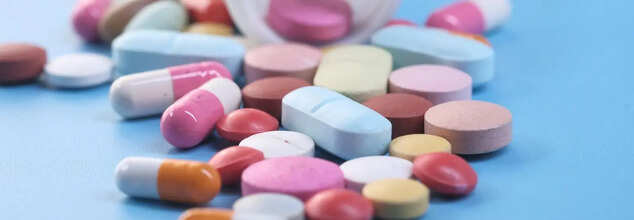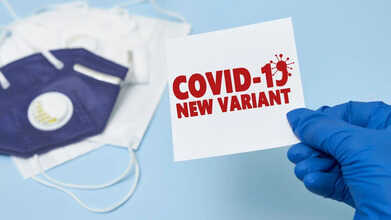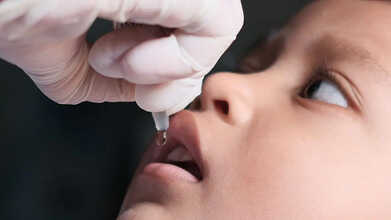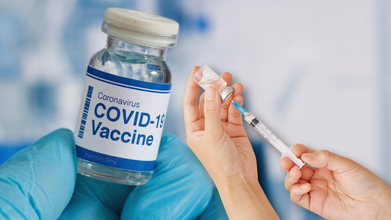- Health Conditions A-Z
- Health & Wellness
- Nutrition
- Fitness
- Health News
- Ayurveda
- Videos
- Medicine A-Z
- Parenting
- Web Stories
Novo Nordisk's Diabetes Drug Could Be Beneficial For Heart, Study Shows

Credit: Canva
Novo Nordisk on Saturday announced that its diabetes pill, Rybelsus, demonstrated cardiovascular benefits in a late-stage trial. The findings pave the way for the medication to become a new treatment option for people living with both diabetes and heart disease.
In the trial, Rybelsus reduced the risk of cardiovascular-related death, heart attack, and stroke by 14% compared to a placebo over an average follow-up period of four years. The study involved patients with Type 2 diabetes and established heart disease, some of whom also had chronic kidney disease. The Danish drugmaker presented these results at the American College of Cardiology’s Annual Scientific Session in Chicago.
Rybelsus, already approved for Type 2 diabetes, is the once-daily oral formulation of Novo Nordisk’s blockbuster weekly injection, Ozempic. Both drugs, along with the company’s weekly weight-loss injection Wegovy, contain semaglutide as their active ingredient.
According to Stephen Gough, Novo Nordisk’s global chief medical officer, the company has submitted applications in the U.S. and EU to expand Rybelsus’ approval to include reducing the risk of serious cardiovascular events. “We know not everybody wants an injection, whether it is painful or not, they want the option of an oral medication,” Gough told CNBC. “We provide that option, that you can have one or the other, depending on what the patients and the healthcare professional think is right in that joint discussion.”
In March 2024, Wegovy received U.S. approval for lowering the risk of major cardiovascular events in adults who are overweight or obese and have heart disease. The new data on Rybelsus suggests an additional option for patients hesitant about injections, offering a more convenient pill-based treatment.
The phase three trial included over 9,600 participants aged 50 and older, who received either Rybelsus or a placebo, in addition to standard therapies. Nearly half of the participants also received SGLT2 inhibitors—commonly used to lower blood sugar—at some point during the trial. By the end, 12% of those on Rybelsus and 13.8% of those on placebo experienced cardiovascular-related death, heart attack, or stroke, amounting to a 14% overall reduction in risk for the Rybelsus group.
The most significant reduction was seen in non-fatal heart attacks, which were reduced by 26%, followed by a 12% drop in non-fatal strokes and a 7% reduction in cardiovascular-related deaths. These findings align with previous trials of injectable GLP-1s like semaglutide, which mimic gut hormones to regulate blood sugar, reduce appetite, and curb inflammation.
While the study showed no major differences in kidney-related outcomes, Gough clarified that the trial primarily focused on heart health. Ozempic, however, is already approved for treating chronic kidney disease in diabetic patients.
Common side effects of Rybelsus were gastrointestinal issues such as nausea, diarrhea, and constipation—similar to those experienced with injectable semaglutide. These symptoms rarely led to patients discontinuing the drug.
Dr. Darren McGuire, the study’s lead author from UT Southwestern Medical Center, noted that despite needing to be taken on an empty stomach at least 30 minutes before eating, patients successfully adhered to Rybelsus and experienced cardiovascular benefits across all age, sex, and health condition subgroups.
New ‘Frankenstein’ Covid-19 Variant Sparks Health Concerns In France; All You Need To Know

Credits: Canva
A recent report from Santé publique France highlights a significant rise in suspected COVID-related visits to emergency departments across the country during the week of September 15–21, 2025 (week 37). Compared with the previous week (September 8–14, week 36), hospital visits linked to COVID increased by 43% among children under 15, with 156 additional visits, and by 29% among adults, with 224 more visits.
Cases among adults had already started climbing the week before. This surge comes as a new SARS-CoV-2 variant, nicknamed “Frankenstein,” becomes increasingly common in France. Here is everything you need to know about this variant, its symptoms, and how to protect yourself.
What Is the Frankenstein Variant?
According to the World Health Organization (WHO), this rise is associated with the emergence of a new variant called XFG. It is nicknamed “Frankenstein” because it is a recombinant, meaning it contains genetic material from two different COVID-19 subtypes, LF.7 and LP.8.1.2. The WHO has classified XFG as a variant under monitoring since June 25, 2025, and it is spreading in several countries worldwide. Current evidence suggests that the public health risk remains low, and approved COVID vaccines are expected to continue preventing severe disease and symptomatic infection. Countries in Southeast Asia have also reported increases in both new cases and hospitalisations in areas where XFG has been widely detected.
Although XFG appears to spread more easily than other variants, experts say it does not seem to cause more severe illness. “The vast majority of infections are mild and resolve within a few days with rest,” said Dr. Gérald Kierzek. Infectious disease specialist Anne-Claude Crémieux added that, so far, there are no signs the variant is more dangerous than previous strains.
Symptoms of the Frankenstein Variant
The symptoms of XFG are similar to those seen with previous COVID-19 variants and are generally mild, resembling a common cold. These may include:
- Sore throat
- Runny or congested nose
- Dry cough
- Fatigue and muscle aches
- Mild fever
- Loss of appetite
Why Is The Variant Called Frankenstein?
The nickname “Frankenstein” reflects the variant’s hybrid nature, as it combines genetic material from multiple COVID-19 subtypes.
Frankenstein Covid Variant: Preventing Infection and Managing Symptoms
There is no treatment specific to XFG, so care follows the same principles used for other COVID variants.
- Vaccination: Current COVID vaccines remain highly effective at preventing severe illness and hospitalisation, even if protection against infection may be slightly reduced.
- Symptom relief: Rest, hydration, fever reducers, and cough medicines can help manage mild symptoms.
- Protective measures: Wearing masks, maintaining hand hygiene, social distancing, and avoiding crowded places remain important.
Research on the Frankenstein variant is ongoing. Since the disease can affect individuals differently, taking personal precautions and consulting a doctor when symptoms appear remain essential.
Oral Cholera Vaccine Shanchol Gets WHO Prequalification; What You Should Know

Credits: Canva
The oral cholera vaccine Shanchol, made in Hyderabad and first developed by Shantha Biotechnics, has received World Health Organization (WHO) prequalification after its production was recently revived under new management. The clearance allows global procurement agencies such as UNICEF, Gavi, and PAHO to source the vaccine for countries where cholera continues to have a serious public health threat, according to GCBC Vaccines. With the approval in place, here’s a closer look at the vaccine, how it works, and why it matters.
Shanchol: What Is the Vaccine?
Dr. K.I. Varaprasad Reddy, founder of Shantha Biotechnics, said, “Shanchol was designed to be an affordable and accessible answer for countries that struggle with repeated cholera outbreaks. The WHO’s prequalification continues that mission.”
Shanchol is an oral, inactivated, bivalent cholera vaccine that protects against Vibrio cholerae, the bacteria responsible for the disease. The name itself is a brand term rather than an abbreviation.
How Does The Shanchol Vaccine Work?
Type of vaccine: Shanchol is a killed whole-cell vaccine, which means it contains dead cholera bacteria. These are used to train the immune system without causing infection. Being bivalent, it offers protection against the two major cholera strains, O1 and O139.
- Administration: The vaccine is taken by mouth and usually given in two doses for full protection.
- Mechanism: Once ingested, the vaccine activates the immune system in the gut, prompting it to produce antibodies that stop Vibrio cholerae from attaching to the intestinal lining. This prevents the infection from taking hold and causing illness.
Shanchol Vaccine: Why It Matters?
- WHO prequalification: The WHO’s approval confirms that Shanchol meets global standards for safety and effectiveness, making it eligible for international procurement.
- Part of global stockpile: It plays a key role in the world’s oral cholera vaccine stockpile, which supports emergency response efforts in regions hit by cholera outbreaks.
- Current use: Shanchol is widely used in mass immunization drives across cholera-prone and outbreak-affected regions.
Production Revival
Originally created by Shantha Biotechnics, the vaccine later came under Sanofi’s ownership, which eventually halted its production. Manufacturing has now resumed under GCBC Vaccines, part of the Gland Family Office. With WHO prequalification restored, Shanchol will once again be distributed globally to support vaccination programs.
The Role of Oral Cholera Vaccines
Oral cholera vaccines (OCVs) such as Shanchol and Dukoral are tools in preventing the spread of cholera, a severe diarrheal disease caused by Vibrio cholerae. Taken orally, they help trigger an immune response in the intestine that limits bacterial infection. These vaccines are especially valuable in areas with poor sanitation and limited access to clean water.
Vishy Chebrol, Executive Director of GCBC Vaccines, said the company’s priority is to ensure that vaccines reach the countries that need them most, affordably and consistently. “We are also working to bring more affordable and innovative vaccines to global markets, continuing Shantha’s legacy of improving access to life-saving immunization,” he added.
With WHO’s renewed approval, Shanchol, a bivalent, killed whole-cell oral cholera vaccine effective against Vibrio cholerae O1 and O139, will continue to be supplied worldwide to meet growing demand and support national immunization programmes.
CDC Changes COVID Vaccine Recommendation: People Should Consult Doctors Before COVID Shot

(Credit-Canva)
The Centers for Disease Control and Prevention (CDC) has approved new rules for the updated COVID-19 vaccines. Acting CDC Director Jim O'Neill accepted the new recommendations for the shots, detailing how people must speak to healthcare professionals about the risks and safety before they get a shot. This decision is the final step needed to start the new rules. It affects who can get the vaccine and if insurance will cover it without extra costs.
These updates put into effect the recent advice from the CDC's main vaccine advisory group (ACIP), which was approved last week by Acting CDC Director Jim O'Neill. The new schedules will be posted on the CDC website by October 7, 2025.
What Are The New Recommendations For COVID Vaccine?
The most significant change is the new step called "shared decision-making." In previous years, anyone could simply walk into a pharmacy or clinic and get a shot for free. Now, the new rules say people must first talk to a doctor, pharmacist, or other healthcare provider about the risks and benefits before getting the vaccine. According to the press release, O'Neill said this means "Informed consent is back," suggesting that previous rules stopped doctors from having these talks. This rule was put in place after an unusual, unexplained two-week wait before the CDC accepted the recommendations.
You and your healthcare provider (doctor, nurse, or pharmacist) must talk about your specific risks and benefits before you decide to get the vaccine. Previously CDC had given a broad recommendation for most people to get a booster shot. However with these guidelines, they will be implored to have a more in-depth conversation about the same.
What Led To The Change In COVID Vaccine Guidelines?
The CDC explained that after a push called Operation Warp Speed (OWS) gave initial shots to nearly 85% of adults, only 23% of adults got the most recent seasonal booster.
Many people were worried about the risks versus the benefits of the boosters, especially since most people already have some immunity from the virus. Experts emphasized that for people under 65, the vaccine's benefits are highest for those at high risk for severe COVID-19 and lowest for healthy individuals with no risk factors. Importantly, this new rule does not stop insurance coverage. All major government and private insurance plans will still cover the vaccine.
Have There Been Changes In Chickenpox Shots?
The CDC's schedule for children now recommends that toddlers (up to age three) get their protection against chickenpox as a standalone shot, instead of using the combined MMRV vaccine (measles, mumps, rubella, and varicella/chickenpox).
Evidence showed that healthy toddlers aged 12–23 months who got the combined MMRV vaccine had a doubled risk of fever-related seizures (febrile seizures) about a week after the shot.
Also Read: A Simple Test That Could Protect You From One Of The Deadliest Cancer According To Top US Doctor
However, the CDC explained that the seizure risk is minor and temporary, but it is not higher if the chickenpox shot is given separately from the MMR shot.
Getting the shots separately provides the same protection against chickenpox. This change is being made to reduce the small chance of this side effect during routine childhood vaccination.
Single Shot Vaccines VS Separate Shots
Following the new guidelines, Acting CDC Director O'Neill also suggested on social media that makers of the combined MMR vaccine should break it up into three separate shots for measles, mumps, and rubella. However, experts have quickly challenged this idea explaining that the combination shot has been used for decades to ensure people get all the necessary protection in one simple shot. Manufacturers also confirmed there is no scientific evidence showing a benefit to using three separate shots.
© 2024 Bennett, Coleman & Company Limited

